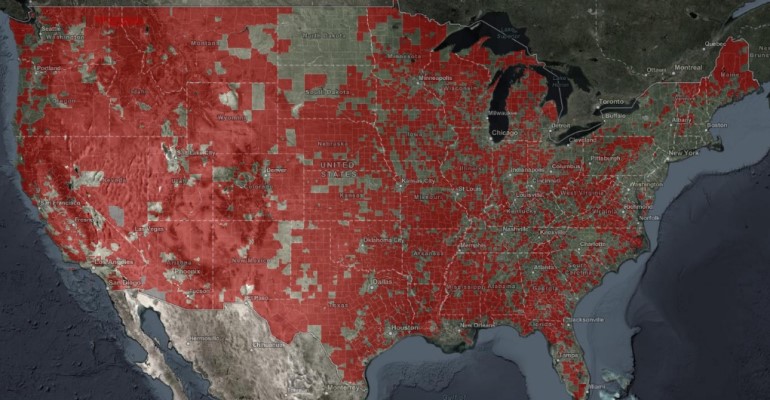
USDA, the Federal Communications Commission and the National Telecommunications and Information Administration announced an interagency agreement to share information about and coordinate the distribution of broadband deployment federal funds.
In accordance with the Broadband Interagency Coordination Act, the respective Cabinet and agency leaders announced that their agencies will consult with one another and share information about the distribution of new funds from the FCC’s high-cost programs that support broadband buildout in rural areas, the USDA’s Rural Utilities Services grant and loan programs and programs administered or coordinated by NTIA.
“Generations ago, the federal government recognized that without affordable access to electricity, Americans couldn’t fully participate in modern society and the modern economy. Broadband internet is the new electricity. It is necessary for Americans to do their jobs, to participate equally in school learning, health care, and to stay connected,” Agriculture Secretary Vilsack says.
Coordination between agencies has consistently been a criticism of expanding rural broadband coverage, and also noted in response to the recent bipartisan infrastructure deal struck between President Joe Biden and senators from both sides of the aisle. The White House announcement indicated the deal included $65 billion for broadband.
Rural Broadband Association Chief Executive Officer Shirley Bloomfield welcomed the inclusion of not just roads and bridges in the infrastructure deal, but also digital infrastructure.
“As a final plan is further defined and comes together, I urge policymakers to aim high and invest in future-proof fiber technology built to last, to ensure that funding is directed towards connecting those most in need first and to coordinate funding among the existing federal and state programs that support and sustain broadband deployment and help keep services in hard-to-reach rural areas affordable,” says Bloomfield.
Agency coordination
Vilsack adds that is why under the current administration, “USDA remains committed to being a strong partner with rural communities and our state, Tribal, and federal partners in building ‘future proof’ broadband infrastructure in unserved and underserved areas so that we finally reach 100% high-speed broadband coverage across the country.”
As part of the signed Agreement, each federal agency partner will share information about existing or planned projects that receive funding from the previously mentioned federal funding sources. Each partner will also, upon request, identify entities providing broadband service in a specified geographic area; the levels of broadband service in that area, including broadband speeds and technologies deployed; the geographic scope of broadband service in that area, each entity in that area that has or will receive funds from these programs. The agreement also requires the federal agency partners to consider basing the distribution of funds from the programs on standardized broadband coverage data.
“The last fifteen months demonstrated like never before that broadband is no longer a luxury, but a necessity. Congress rightfully funded broadband deployment at levels we’ve seldom seen in recent years in response to the pandemic,” says FCC Acting Chairwoman Jessica Rosenworcel. “In order to be good stewards of funds supporting these projects, I’m proud to announce with my colleagues that the FCC, NTIA, and USDA will strengthen our coordination to ensure that we make the most effective use of these new funds.”
Rosenworcel thanked Vilsack and Acting Assistant Secretary Remaley for their leadership and partnership. “Working together, we’ll be better able to meet our shared goal of getting 100% of Americans connected to the high-speed internet access they need to thrive.”
U.S. Secretary of Commerce Gina M. Raimondo adds, “Access to reliable, affordable high-speed broadband is critical to the economic well-being of communities and small businesses across America.”
Raimondo notes the announcement lays important groundwork for collaboration between agencies to ensure the federal government’s efforts to expand broadband access are as effective and efficient as possible, reaching every corner of the country.”
Maps reveal true digital divide
NTIA recently released a new publicly available digital map that displays key indicators of broadband needs across the country. This is the first interactive, public map that allows users to explore different datasets about where people do not have quality Internet access.
The public “Indicators of Broadband Need” tool released June 17 puts on one map, for the first time, data from both public and private sources. It contains data aggregated at the county, census tract, and census block level from the U.S. Census Bureau, the FCC, M-Lab, Ookla and Microsoft. Speed-test data provided by M-Lab and Ookla help to illustrate the reality that communities experience when going online, with many parts of the country reporting speeds that fall below the FCC’s current benchmark for fixed broadband service of 25 Mbps download, 3 Mbps upload.
“Any effort to close the digital divide starts with solid data, and NTIA continues to help policymakers make more informed decisions on expanding broadband access,�” says Acting NTIA Administrator Evelyn Remaley. “Now, the public can benefit from our platform to see which areas of the country still don’t have broadband at speeds needed to participate in the modern economy.”
Read more about:
BroadbandAbout the Author(s)
You May Also Like






